International Marketing Report: Culture's Influence on Global Markets
VerifiedAdded on 2020/03/16
|7
|1484
|52
Report
AI Summary
This report explores the profound impact of culture on international marketing practices. It begins by defining culture and highlighting its dynamic nature across different societies. The report then delves into specific cultural elements, including language, religion, social institutions, material life, standard of living, urban culture, and social interactions, illustrating their direct influence on marketing strategies. It emphasizes the importance of cultural analysis, discussing approaches such as ethnocentrism, host-country perspective, and assimilation. The report concludes by acknowledging the effects of globalization while stressing the continued necessity of understanding cultural nuances for successful international marketing, emphasizing the importance of tailoring strategies to the specific cultural contexts of target markets. The report also references several academic sources to support its analysis.
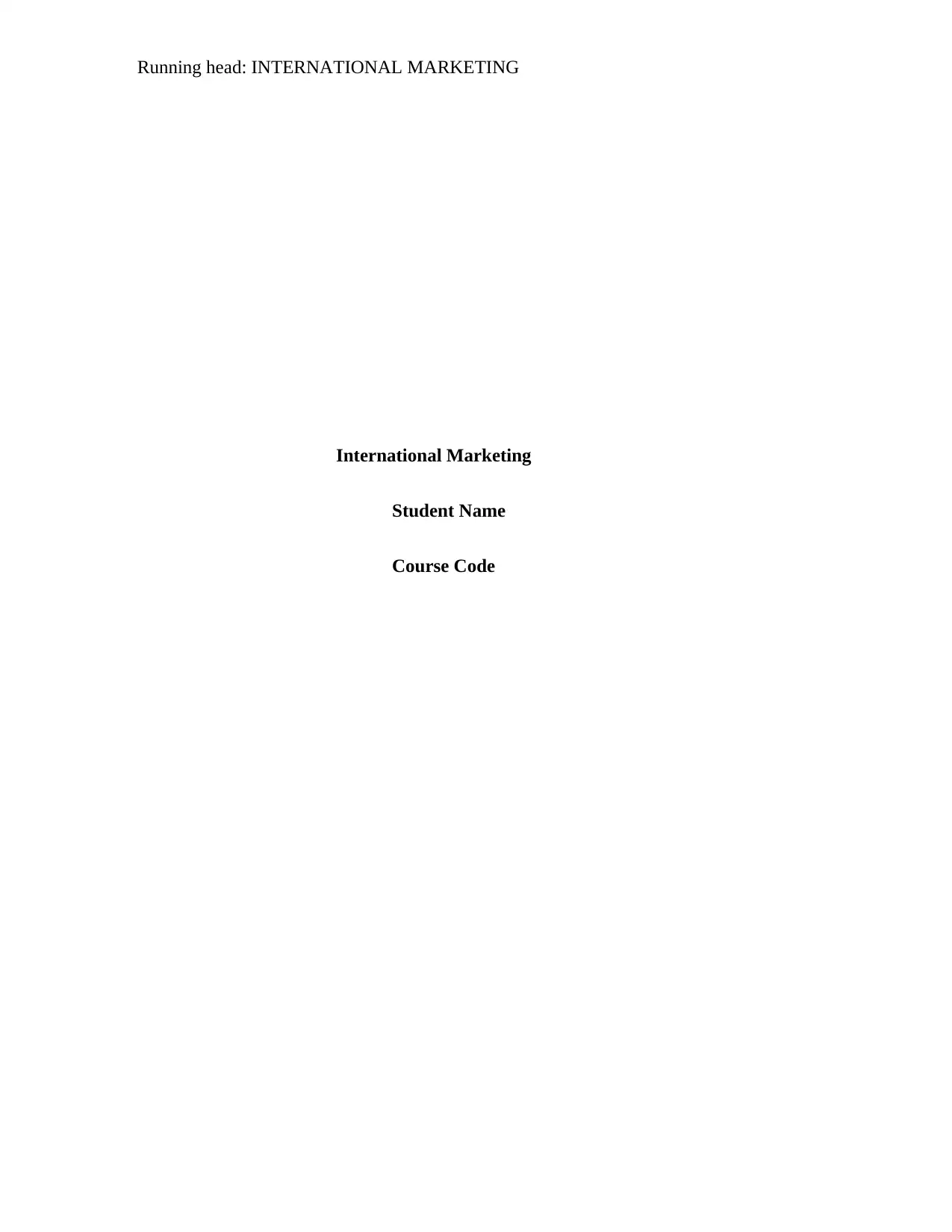
Running head: INTERNATIONAL MARKETING
International Marketing
Student Name
Course Code
International Marketing
Student Name
Course Code
Paraphrase This Document
Need a fresh take? Get an instant paraphrase of this document with our AI Paraphraser
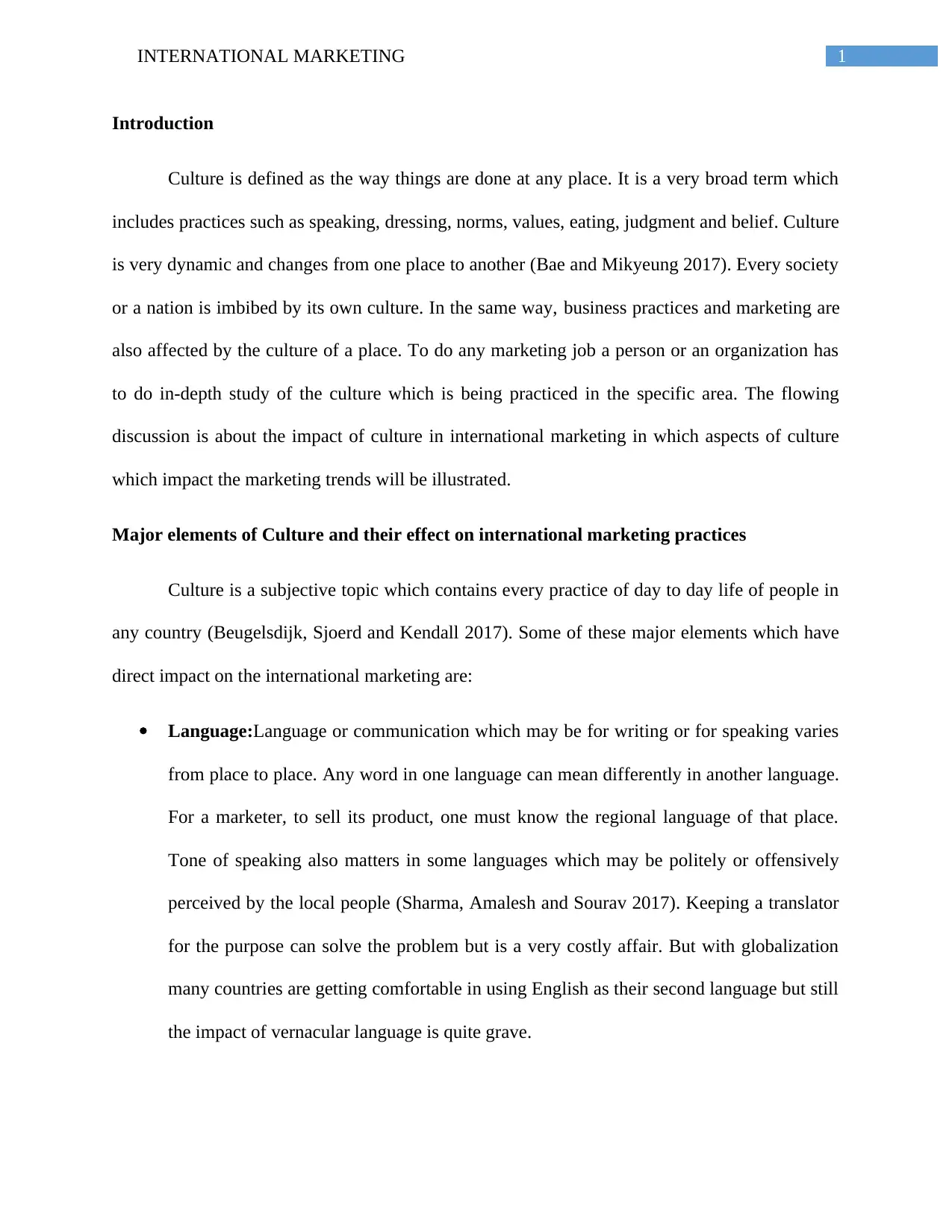
1INTERNATIONAL MARKETING
Introduction
Culture is defined as the way things are done at any place. It is a very broad term which
includes practices such as speaking, dressing, norms, values, eating, judgment and belief. Culture
is very dynamic and changes from one place to another (Bae and Mikyeung 2017). Every society
or a nation is imbibed by its own culture. In the same way, business practices and marketing are
also affected by the culture of a place. To do any marketing job a person or an organization has
to do in-depth study of the culture which is being practiced in the specific area. The flowing
discussion is about the impact of culture in international marketing in which aspects of culture
which impact the marketing trends will be illustrated.
Major elements of Culture and their effect on international marketing practices
Culture is a subjective topic which contains every practice of day to day life of people in
any country (Beugelsdijk, Sjoerd and Kendall 2017). Some of these major elements which have
direct impact on the international marketing are:
Language:Language or communication which may be for writing or for speaking varies
from place to place. Any word in one language can mean differently in another language.
For a marketer, to sell its product, one must know the regional language of that place.
Tone of speaking also matters in some languages which may be politely or offensively
perceived by the local people (Sharma, Amalesh and Sourav 2017). Keeping a translator
for the purpose can solve the problem but is a very costly affair. But with globalization
many countries are getting comfortable in using English as their second language but still
the impact of vernacular language is quite grave.
Introduction
Culture is defined as the way things are done at any place. It is a very broad term which
includes practices such as speaking, dressing, norms, values, eating, judgment and belief. Culture
is very dynamic and changes from one place to another (Bae and Mikyeung 2017). Every society
or a nation is imbibed by its own culture. In the same way, business practices and marketing are
also affected by the culture of a place. To do any marketing job a person or an organization has
to do in-depth study of the culture which is being practiced in the specific area. The flowing
discussion is about the impact of culture in international marketing in which aspects of culture
which impact the marketing trends will be illustrated.
Major elements of Culture and their effect on international marketing practices
Culture is a subjective topic which contains every practice of day to day life of people in
any country (Beugelsdijk, Sjoerd and Kendall 2017). Some of these major elements which have
direct impact on the international marketing are:
Language:Language or communication which may be for writing or for speaking varies
from place to place. Any word in one language can mean differently in another language.
For a marketer, to sell its product, one must know the regional language of that place.
Tone of speaking also matters in some languages which may be politely or offensively
perceived by the local people (Sharma, Amalesh and Sourav 2017). Keeping a translator
for the purpose can solve the problem but is a very costly affair. But with globalization
many countries are getting comfortable in using English as their second language but still
the impact of vernacular language is quite grave.
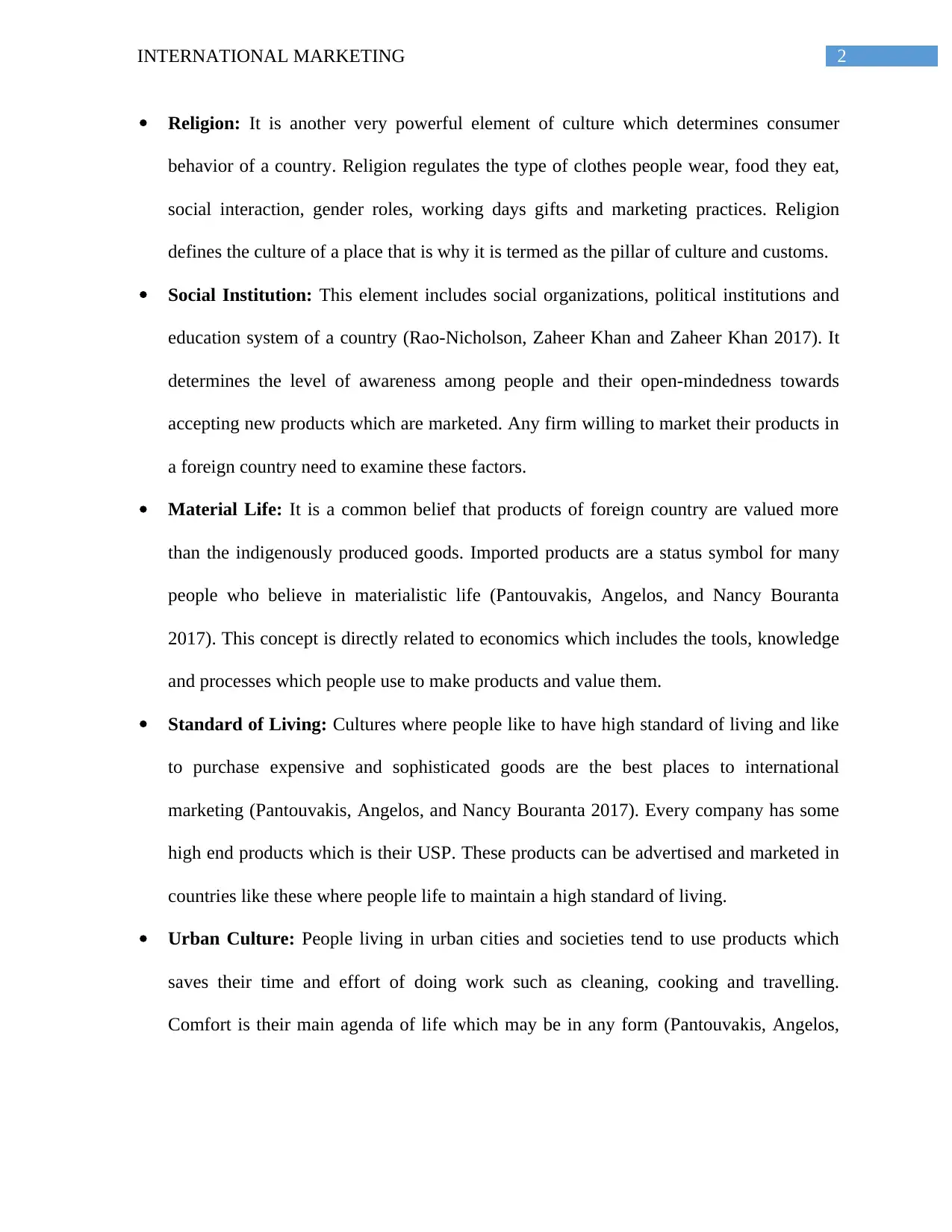
2INTERNATIONAL MARKETING
Religion: It is another very powerful element of culture which determines consumer
behavior of a country. Religion regulates the type of clothes people wear, food they eat,
social interaction, gender roles, working days gifts and marketing practices. Religion
defines the culture of a place that is why it is termed as the pillar of culture and customs.
Social Institution: This element includes social organizations, political institutions and
education system of a country (Rao-Nicholson, Zaheer Khan and Zaheer Khan 2017). It
determines the level of awareness among people and their open-mindedness towards
accepting new products which are marketed. Any firm willing to market their products in
a foreign country need to examine these factors.
Material Life: It is a common belief that products of foreign country are valued more
than the indigenously produced goods. Imported products are a status symbol for many
people who believe in materialistic life (Pantouvakis, Angelos, and Nancy Bouranta
2017). This concept is directly related to economics which includes the tools, knowledge
and processes which people use to make products and value them.
Standard of Living: Cultures where people like to have high standard of living and like
to purchase expensive and sophisticated goods are the best places to international
marketing (Pantouvakis, Angelos, and Nancy Bouranta 2017). Every company has some
high end products which is their USP. These products can be advertised and marketed in
countries like these where people life to maintain a high standard of living.
Urban Culture: People living in urban cities and societies tend to use products which
saves their time and effort of doing work such as cleaning, cooking and travelling.
Comfort is their main agenda of life which may be in any form (Pantouvakis, Angelos,
Religion: It is another very powerful element of culture which determines consumer
behavior of a country. Religion regulates the type of clothes people wear, food they eat,
social interaction, gender roles, working days gifts and marketing practices. Religion
defines the culture of a place that is why it is termed as the pillar of culture and customs.
Social Institution: This element includes social organizations, political institutions and
education system of a country (Rao-Nicholson, Zaheer Khan and Zaheer Khan 2017). It
determines the level of awareness among people and their open-mindedness towards
accepting new products which are marketed. Any firm willing to market their products in
a foreign country need to examine these factors.
Material Life: It is a common belief that products of foreign country are valued more
than the indigenously produced goods. Imported products are a status symbol for many
people who believe in materialistic life (Pantouvakis, Angelos, and Nancy Bouranta
2017). This concept is directly related to economics which includes the tools, knowledge
and processes which people use to make products and value them.
Standard of Living: Cultures where people like to have high standard of living and like
to purchase expensive and sophisticated goods are the best places to international
marketing (Pantouvakis, Angelos, and Nancy Bouranta 2017). Every company has some
high end products which is their USP. These products can be advertised and marketed in
countries like these where people life to maintain a high standard of living.
Urban Culture: People living in urban cities and societies tend to use products which
saves their time and effort of doing work such as cleaning, cooking and travelling.
Comfort is their main agenda of life which may be in any form (Pantouvakis, Angelos,
⊘ This is a preview!⊘
Do you want full access?
Subscribe today to unlock all pages.

Trusted by 1+ million students worldwide
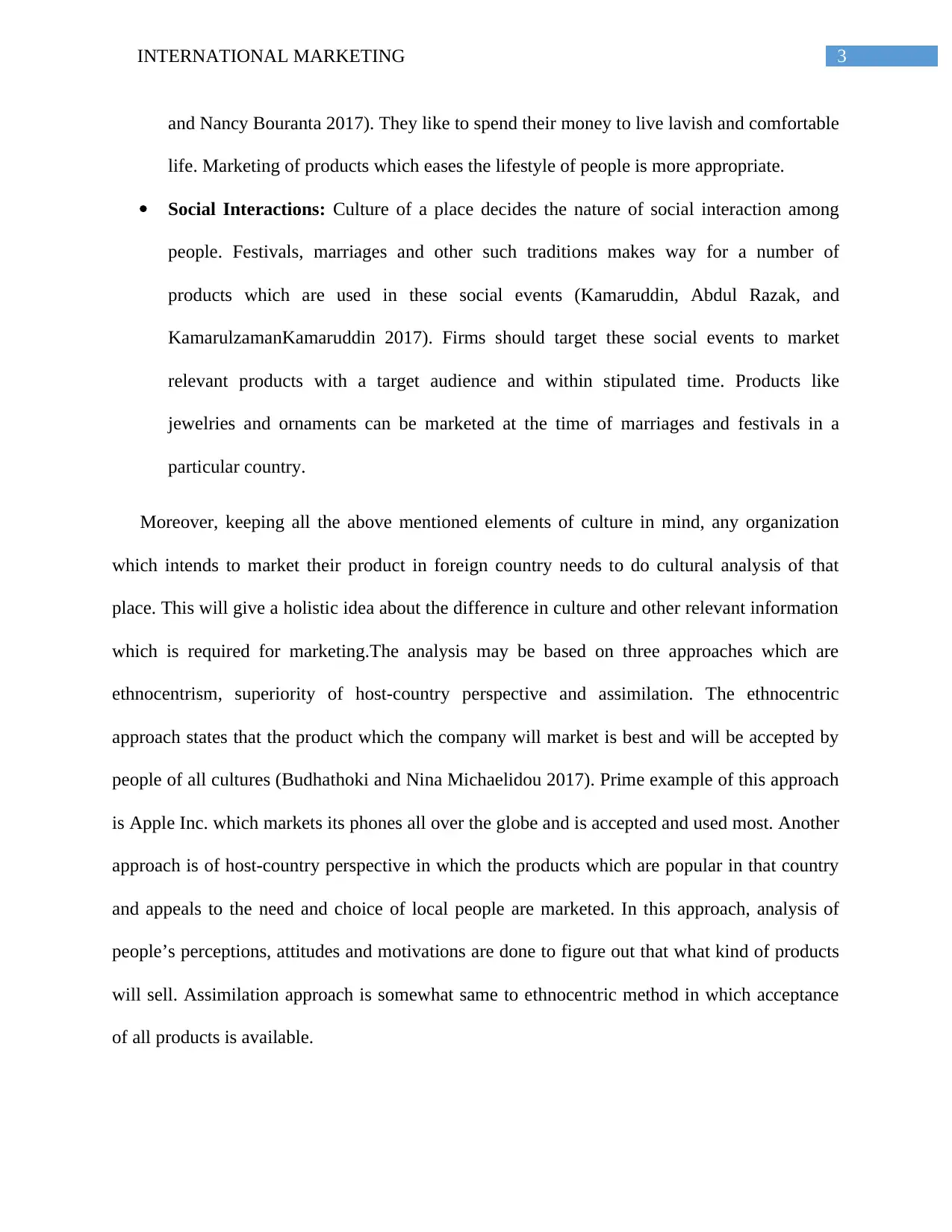
3INTERNATIONAL MARKETING
and Nancy Bouranta 2017). They like to spend their money to live lavish and comfortable
life. Marketing of products which eases the lifestyle of people is more appropriate.
Social Interactions: Culture of a place decides the nature of social interaction among
people. Festivals, marriages and other such traditions makes way for a number of
products which are used in these social events (Kamaruddin, Abdul Razak, and
KamarulzamanKamaruddin 2017). Firms should target these social events to market
relevant products with a target audience and within stipulated time. Products like
jewelries and ornaments can be marketed at the time of marriages and festivals in a
particular country.
Moreover, keeping all the above mentioned elements of culture in mind, any organization
which intends to market their product in foreign country needs to do cultural analysis of that
place. This will give a holistic idea about the difference in culture and other relevant information
which is required for marketing.The analysis may be based on three approaches which are
ethnocentrism, superiority of host-country perspective and assimilation. The ethnocentric
approach states that the product which the company will market is best and will be accepted by
people of all cultures (Budhathoki and Nina Michaelidou 2017). Prime example of this approach
is Apple Inc. which markets its phones all over the globe and is accepted and used most. Another
approach is of host-country perspective in which the products which are popular in that country
and appeals to the need and choice of local people are marketed. In this approach, analysis of
people’s perceptions, attitudes and motivations are done to figure out that what kind of products
will sell. Assimilation approach is somewhat same to ethnocentric method in which acceptance
of all products is available.
and Nancy Bouranta 2017). They like to spend their money to live lavish and comfortable
life. Marketing of products which eases the lifestyle of people is more appropriate.
Social Interactions: Culture of a place decides the nature of social interaction among
people. Festivals, marriages and other such traditions makes way for a number of
products which are used in these social events (Kamaruddin, Abdul Razak, and
KamarulzamanKamaruddin 2017). Firms should target these social events to market
relevant products with a target audience and within stipulated time. Products like
jewelries and ornaments can be marketed at the time of marriages and festivals in a
particular country.
Moreover, keeping all the above mentioned elements of culture in mind, any organization
which intends to market their product in foreign country needs to do cultural analysis of that
place. This will give a holistic idea about the difference in culture and other relevant information
which is required for marketing.The analysis may be based on three approaches which are
ethnocentrism, superiority of host-country perspective and assimilation. The ethnocentric
approach states that the product which the company will market is best and will be accepted by
people of all cultures (Budhathoki and Nina Michaelidou 2017). Prime example of this approach
is Apple Inc. which markets its phones all over the globe and is accepted and used most. Another
approach is of host-country perspective in which the products which are popular in that country
and appeals to the need and choice of local people are marketed. In this approach, analysis of
people’s perceptions, attitudes and motivations are done to figure out that what kind of products
will sell. Assimilation approach is somewhat same to ethnocentric method in which acceptance
of all products is available.
Paraphrase This Document
Need a fresh take? Get an instant paraphrase of this document with our AI Paraphraser
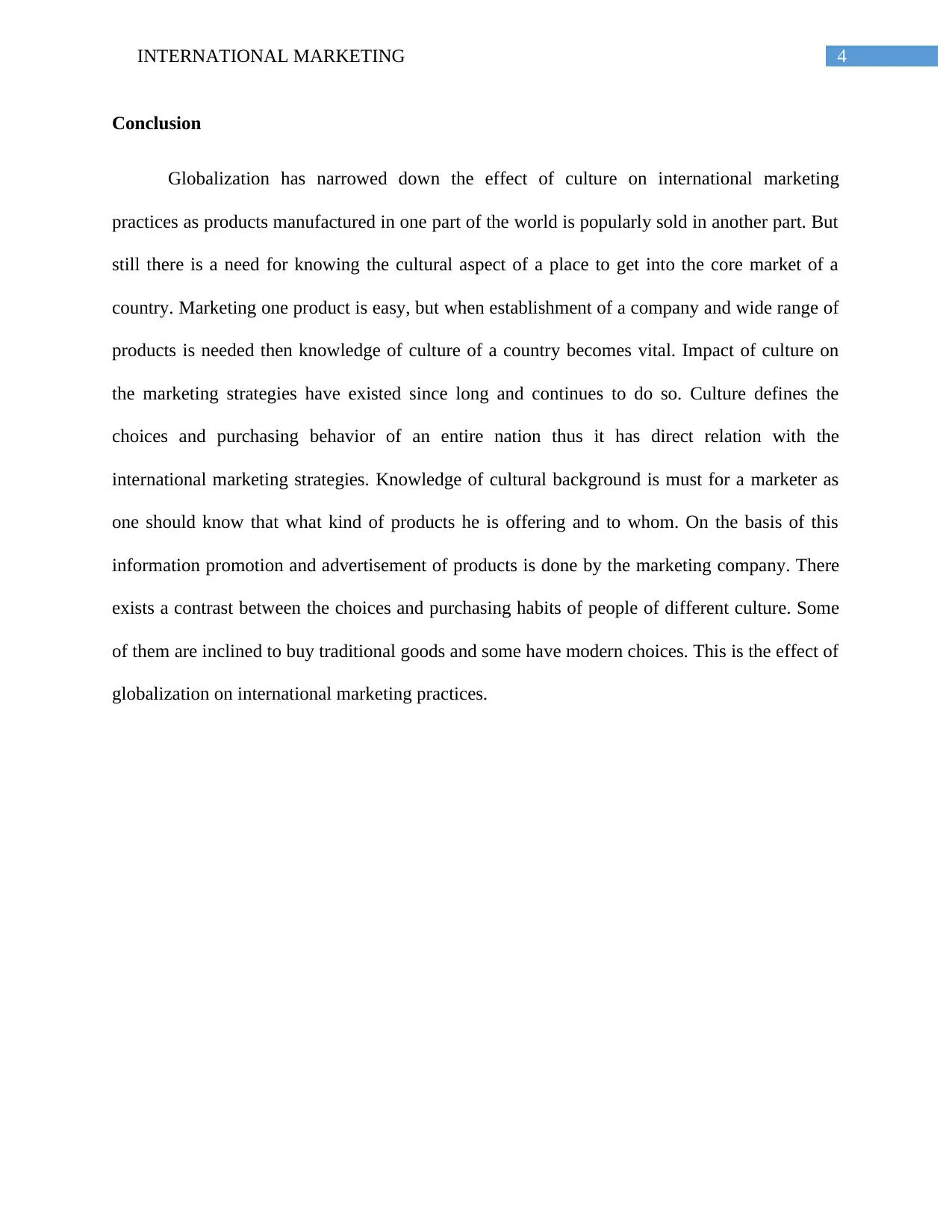
4INTERNATIONAL MARKETING
Conclusion
Globalization has narrowed down the effect of culture on international marketing
practices as products manufactured in one part of the world is popularly sold in another part. But
still there is a need for knowing the cultural aspect of a place to get into the core market of a
country. Marketing one product is easy, but when establishment of a company and wide range of
products is needed then knowledge of culture of a country becomes vital. Impact of culture on
the marketing strategies have existed since long and continues to do so. Culture defines the
choices and purchasing behavior of an entire nation thus it has direct relation with the
international marketing strategies. Knowledge of cultural background is must for a marketer as
one should know that what kind of products he is offering and to whom. On the basis of this
information promotion and advertisement of products is done by the marketing company. There
exists a contrast between the choices and purchasing habits of people of different culture. Some
of them are inclined to buy traditional goods and some have modern choices. This is the effect of
globalization on international marketing practices.
Conclusion
Globalization has narrowed down the effect of culture on international marketing
practices as products manufactured in one part of the world is popularly sold in another part. But
still there is a need for knowing the cultural aspect of a place to get into the core market of a
country. Marketing one product is easy, but when establishment of a company and wide range of
products is needed then knowledge of culture of a country becomes vital. Impact of culture on
the marketing strategies have existed since long and continues to do so. Culture defines the
choices and purchasing behavior of an entire nation thus it has direct relation with the
international marketing strategies. Knowledge of cultural background is must for a marketer as
one should know that what kind of products he is offering and to whom. On the basis of this
information promotion and advertisement of products is done by the marketing company. There
exists a contrast between the choices and purchasing habits of people of different culture. Some
of them are inclined to buy traditional goods and some have modern choices. This is the effect of
globalization on international marketing practices.
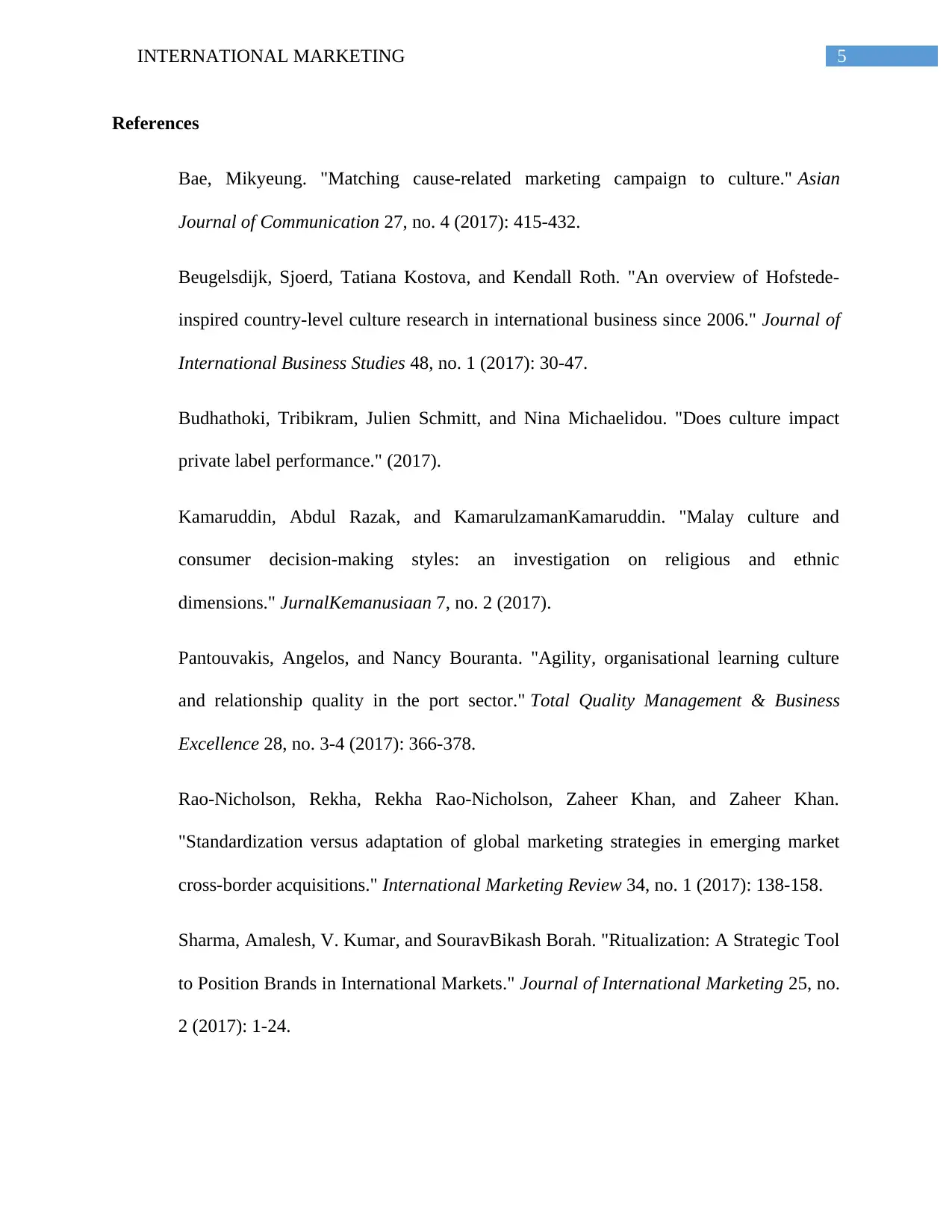
5INTERNATIONAL MARKETING
References
Bae, Mikyeung. "Matching cause-related marketing campaign to culture." Asian
Journal of Communication 27, no. 4 (2017): 415-432.
Beugelsdijk, Sjoerd, Tatiana Kostova, and Kendall Roth. "An overview of Hofstede-
inspired country-level culture research in international business since 2006." Journal of
International Business Studies 48, no. 1 (2017): 30-47.
Budhathoki, Tribikram, Julien Schmitt, and Nina Michaelidou. "Does culture impact
private label performance." (2017).
Kamaruddin, Abdul Razak, and KamarulzamanKamaruddin. "Malay culture and
consumer decision-making styles: an investigation on religious and ethnic
dimensions." JurnalKemanusiaan 7, no. 2 (2017).
Pantouvakis, Angelos, and Nancy Bouranta. "Agility, organisational learning culture
and relationship quality in the port sector." Total Quality Management & Business
Excellence 28, no. 3-4 (2017): 366-378.
Rao-Nicholson, Rekha, Rekha Rao-Nicholson, Zaheer Khan, and Zaheer Khan.
"Standardization versus adaptation of global marketing strategies in emerging market
cross-border acquisitions." International Marketing Review 34, no. 1 (2017): 138-158.
Sharma, Amalesh, V. Kumar, and SouravBikash Borah. "Ritualization: A Strategic Tool
to Position Brands in International Markets." Journal of International Marketing 25, no.
2 (2017): 1-24.
References
Bae, Mikyeung. "Matching cause-related marketing campaign to culture." Asian
Journal of Communication 27, no. 4 (2017): 415-432.
Beugelsdijk, Sjoerd, Tatiana Kostova, and Kendall Roth. "An overview of Hofstede-
inspired country-level culture research in international business since 2006." Journal of
International Business Studies 48, no. 1 (2017): 30-47.
Budhathoki, Tribikram, Julien Schmitt, and Nina Michaelidou. "Does culture impact
private label performance." (2017).
Kamaruddin, Abdul Razak, and KamarulzamanKamaruddin. "Malay culture and
consumer decision-making styles: an investigation on religious and ethnic
dimensions." JurnalKemanusiaan 7, no. 2 (2017).
Pantouvakis, Angelos, and Nancy Bouranta. "Agility, organisational learning culture
and relationship quality in the port sector." Total Quality Management & Business
Excellence 28, no. 3-4 (2017): 366-378.
Rao-Nicholson, Rekha, Rekha Rao-Nicholson, Zaheer Khan, and Zaheer Khan.
"Standardization versus adaptation of global marketing strategies in emerging market
cross-border acquisitions." International Marketing Review 34, no. 1 (2017): 138-158.
Sharma, Amalesh, V. Kumar, and SouravBikash Borah. "Ritualization: A Strategic Tool
to Position Brands in International Markets." Journal of International Marketing 25, no.
2 (2017): 1-24.
⊘ This is a preview!⊘
Do you want full access?
Subscribe today to unlock all pages.

Trusted by 1+ million students worldwide
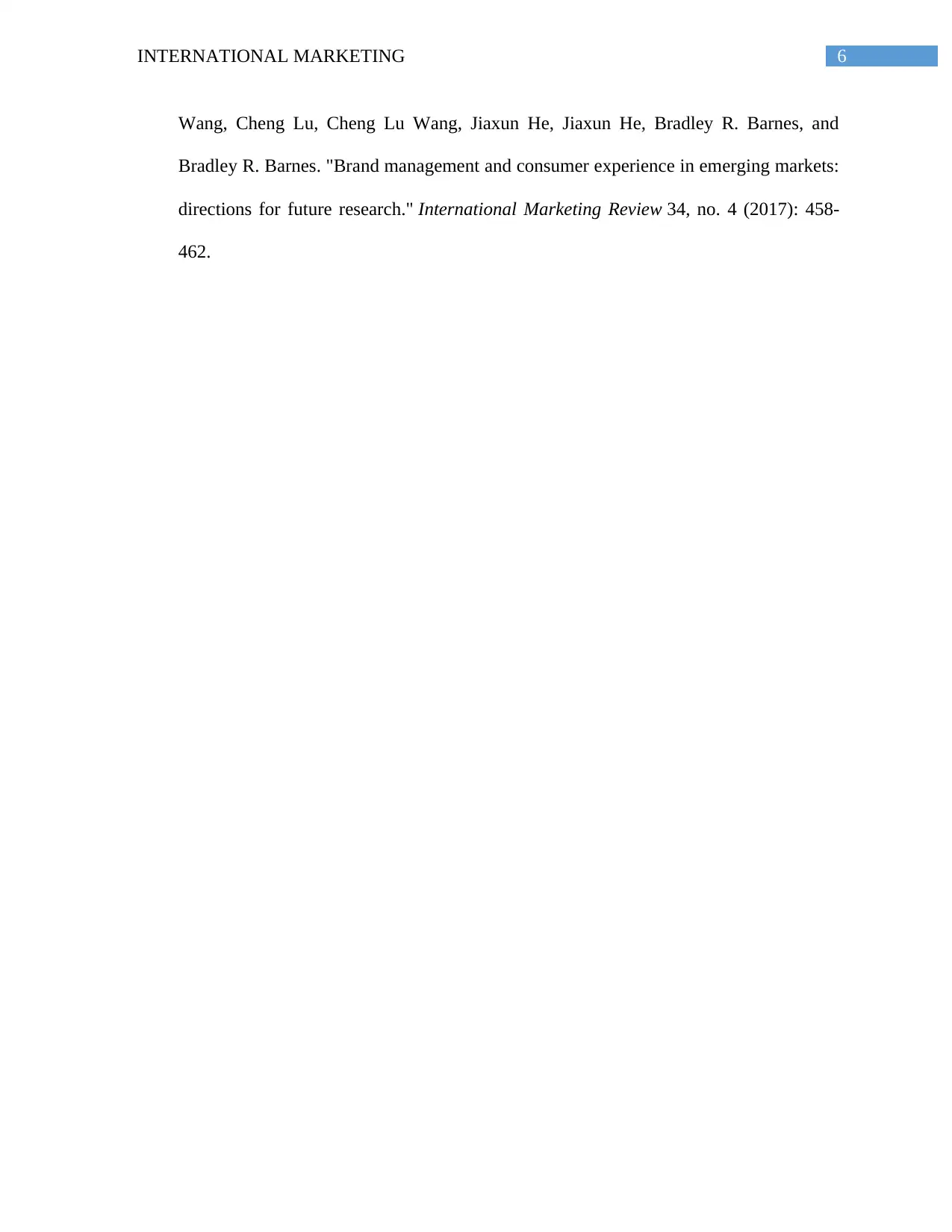
6INTERNATIONAL MARKETING
Wang, Cheng Lu, Cheng Lu Wang, Jiaxun He, Jiaxun He, Bradley R. Barnes, and
Bradley R. Barnes. "Brand management and consumer experience in emerging markets:
directions for future research." International Marketing Review 34, no. 4 (2017): 458-
462.
Wang, Cheng Lu, Cheng Lu Wang, Jiaxun He, Jiaxun He, Bradley R. Barnes, and
Bradley R. Barnes. "Brand management and consumer experience in emerging markets:
directions for future research." International Marketing Review 34, no. 4 (2017): 458-
462.
1 out of 7
Related Documents
Your All-in-One AI-Powered Toolkit for Academic Success.
+13062052269
info@desklib.com
Available 24*7 on WhatsApp / Email
![[object Object]](/_next/static/media/star-bottom.7253800d.svg)
Unlock your academic potential
Copyright © 2020–2025 A2Z Services. All Rights Reserved. Developed and managed by ZUCOL.





